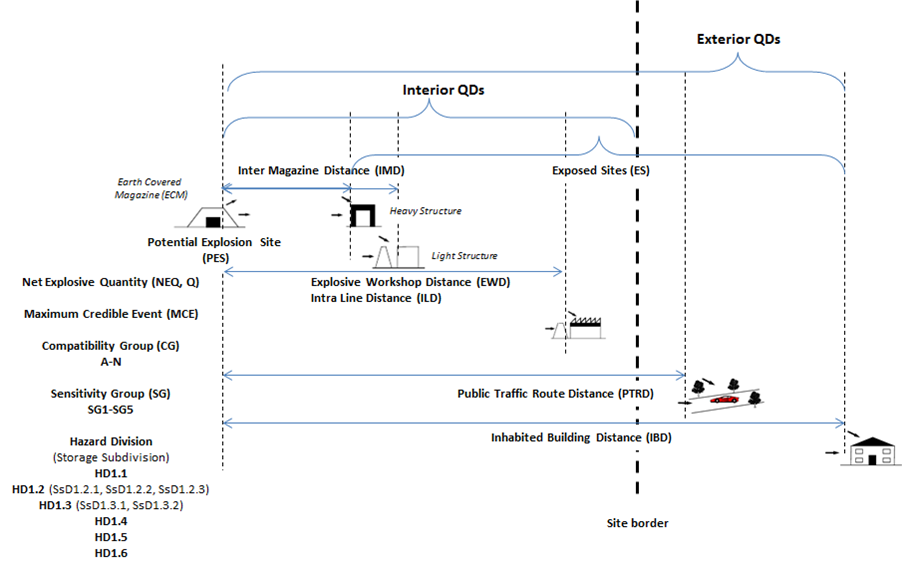Experimental and Theoretical basis of current NATO Standards for safe storage of ammunition and explosives
Good progress has been made within the project “Experimental and Theoretical basis of current NATO standards for safe storage of ammunition and explosives”. The results obtained so far have been presented at various meetings and have been reported in a paper for the Military Air Blast Symposium (MABS) which is to be held in Halifax, Canada (19-23 September). The work will also be presented at the OME symposium in the UK (1-2 November). Because the topic of this study is very broad and complex, we asked various international colleagues for their review and feedback.

Graphical overview of “QD terminology”.
The abstract of the paper is given below:
“NATO standards for the safe storage of ammunition and explosives contain tables with so-called Quantity Distances (QDs). These distances are aimed to provide an acceptable protection level to surrounding Exposed Sites (ES) in the event of an accidental explosion of a Potential Explosion Site (PES). The development of the standards took place over many decades by explosives safety experts. The QDs are based on the analysis of a large number of explosives tests- and accident data. Based on additional testing and analysis accomplished in recent years, a comprehensive and transparent overview of the basis for the QDs is necessary in order to validate them and to eliminate inconsistencies.
The Munitions Safety Information Analysis Center (MSIAC) conducted a study on the experimental and theoretical basis of QDs. This paper presents a structured approach to QDs, starting with the amount of munitions involved in the munitions response, and then treating each explosion effect separately.
Relevant references that support the standards have been analyzed. QDs have been compared to state-of-the-art prediction models for blast wave propagation and observed damage. The basis of those QDs that are dominated by fragments and structural debris is discussed as well. Planned changes to the NATO standards, such as the implementation of QDs for small quantities of explosives, are taken into account. Knowledge gaps have been identified and recommendations for long term development have also been made. A more detailed report as well as a repository of all references will be completed towards the end of 2016.”
Interested parties can download the paper through this link: https://www.msiac.nato.inthttps://www.msiac.nato.int/sites/default/files/attachments/mabs_2016_p187_van_der_voort_msiac_basis_of_qd_lowres.pdf.
The paper concludes with an overview of those assumptions that make AASTP-1 and AASTP-5 conservative, but also addresses a number of aspects that may lead to potentially unsafe situations. A number of recommendations are given related to the harmonization of standards and to better address QDs for Insensitive Munitions. Interesting recommendations for the long term are given as well:
- A development towards more physics-based QDs in combination with clear acceptance criteria in terms of explosion effects or consequences is recommended. QDs with a larger fidelity avoid the need to split up tables for different NEQ ranges, with associated discontinuity problems at the boundaries. It also avoids the need to make assumption for situations that require “No QD”.
- More advanced debris IBD models could be used that take into account building parameters like dimensions, wall thickness and door properties, and also provide reduced QD in off-normal directions.
- The development of QDs could benefit from a closer cooperation with expert groups on testing and modeling of explosion effects and consequences. Examples are the Klotz Group and the AASTP-4 CWG. Ideally speaking the explosion effect models reported in AASTP-4 and QDs and FDs provided in AASTP-1 and AASTP-5 should be consistent.
- Instead of presenting QDs in table format, they could be provided by means of a calculation tool. This prevents human error, and also avoids issues about rounding and interpolation.
A number of the recommendations will be addressed in the upcoming Technical Working Group for AASTP-1 Part 1 (5-6 September) in preparation for the AC/326 SGC meeting (7-9 September).
The Stokes fellow project “Benefits of IM”, which is currently being carried out by Ben Keefe (UK) has a direct link with this work. Ben will finish his project end of August, and a summary of Ben’s findings will be mentioned in the next newsletter.


